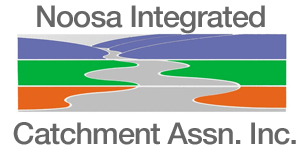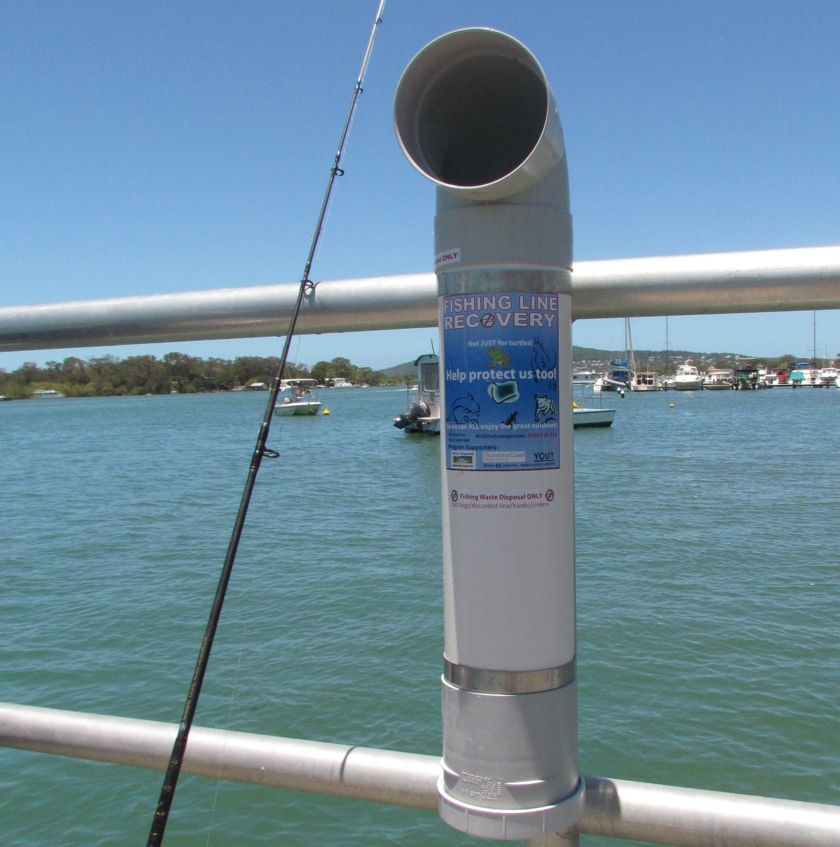Project Description
This project was initially undertaken in 2004 to effectively reduce the amount of fishing line litter found in the waterways and coastal zones of the Noosa area. Based on on a model from the Florida Fish and Wildlife Conservation Commission Monofilament Recovery Project in the US, this project is Australia’s very first. Initially designed to target fishing line litter alone, the project was adapted to include bait bags, hooks, sinkers – in short, all recreational-fishing related waste items.
Aims
Funded by Noosa Council the project aims to:
- Raise public awareness about the hazards associated with recreational -fishing related waste: fishing line, hooks lures, sinkers, bait bags/containers etc.
- Prevent wildlife injury/death associated with fishing line entanglement, ingestion, etc.
- Prevent leeching contamination of ground and waterways from lead-containing sinkers.
- Protect habitats intertidal and tidal habitats (mangrove, seagrass, sand flats, etc.) that are in direct threat from fishing waste build-up.
- Ensure local vegetation is kept free from fishing line litter.
- Protect landfill animals such as Ibis, Brahmini Kites and other raptor species, possums and other scavengers.
- Mitigate impacts of fishing related harmful materials on other park and waterways users, such as dogs, swimmers and boat owners.
Potential Harm
Wildlife injury and death caused by fishing line/hook entanglement and ingestion.
- Marine and aquatic species associated with this impact include marine turtles, pelicans, waders and shorebirds, dolphins, sharks and stingrays.
- Terrestrial species associated with this impact include possums, tree nesting birds and flying foxes.
Toxic lead poisoning
- Although some newer types of fishing sinkers are formulated to no longer contain lead, many other, commonly available ones, still do contain lead, which leeches into the groundwater when discarded.
- In addition, direct impact through ingestion poses specific threat to certain species. Swans are one example: Feeding on seagrass, and other underwater vegetation, along muddy/sandy lake beds these birds accidentally ingest pellets/sinkers along with the vegetation. Long, slow death through lead poisoning is the inevitable result.
Non wildlife impacts
- Dogs in public parks popular for recreational fishing are potentially exposed to discarded line and hooks, which are ingested; particularly hooks with a residual bait remaining. Resulting injuries often require surgery, and can even lead to death.
- Children, and other swimmers at public jetties and beaches popular for recreational fishing are potentially exposed to discarded hooks, which cause painful injuries if trodden upon barefoot.
- Discarded or improperly disposed of fishing line, bait bags that end up in the waterways are easily, and often entangled and “ingested” by outboard motors, resulting in costly damage and destruction of equipment. Beyond the cost, and inconvenience, resulting equipment failure could pose a serious danger and threat to life. For example, fishing line becoming entangled in a propeller, or on the propeller shaft will not necessarily cause immediate failure. However if not removed, inevitable and irreparable damage will result, causing outboard failure. If eventual failure were to occur in open water, stranding the boat with no way to safely navigate the sandbars in the mouth of the Noosa River, a potentially life-threatening situation could result.
“Down-stream” impacts: Landfill exposure
- Disposing of recreational fishing-related waste (fishing line, hooks, lures, sinkers, bat bags/containers, etc) in a general rubbish bin allows these materials to reach landfill exposed. Once there, wildlife continues to be exposed to entanglement and ingestion hazards.
- Species likely to encounter this hazard include scavengingn species such s Ibis, Brahmini and Whistling Kites, possums and tree nesting birds.
- Animals not specifically targeting the material itself are still impacted – landfills provide a rich, irrestistable feeding ground; while scavenging for kitchen scraps, hooking entanglements in fishing line can easily occur, – tree nesting birds are known to target fishing line as next building material. This can occur anywhere that discarded fishing line is exposed; on the ground near fishing areas, or once it has reached landfill exposed.
- Light materials, such as plastic bat bags, and even lengths of fishing line, can be carried off-site by strong winds, or heavy rainfall and thus be reintroduced to the environment, continuing to expose wildlife to potential injury and death.
Waste from Fishing Line Recovery Bins is placed in heavy duty bags and securely closed, similar to “Clean up Australia Day” bags, thus containing the hazardous materials, keeping wildlife in landfill environments out of harm’s way, and preventing wind and rain transport.
Latest Developments
In 2010 the project was revitalized in an effort to increase its effectiveness in mitigating impacts caused by improperly disposed of recreational fishing related waste materials. Several actions were taken to this end;
- A renewed public education campaign, aimed at raising awareness of the issues addressed by this project, locations of Fishing Line Recovery Bins in the Noosa area, landfill impacts caused by fishing related wastes disposed of in general rubbish.
- Additional Fishing Line Recovery Bins deployed in the Noosa River area, in response to the growth in Noosa’s population, and subsequent numbers of fishers, since the project’s inception in 2004. These new Fishing Line Recovery Bins were strategically deployed at new public fishing locations, such as fishing jetties provided by council for the community’s use, and at popular fishing locations along the Noosa River. These additions bring the current number of bins in the Noosa area to 40. Click here for a Google Map showing pinpointed location details for each.
- Along with increasing the number of Fishing Line Recovery Bins in the Community, increased business connections have been created, helping to foster business and community support. This support has ranged from hosting of Fishing Line Recovery Bins on site. Examples include boat and fishing hire businesses along Gympie Terrace, bait and tackle shops and petrol stations selling bait in the Noosa area.
Outcomes
Essentially, the fishing line recovery bins, strategically positioned at popular fishing spots, will help make local residents and tourists more aware of the continued environmental degradation and impacts on wildlife caused by inappropriate disposal of waste fishing line.This increased awareness includes gaining an understanding of the potential scope of these impacts. Impacts felt by wildlife can be direct, through entanglements and ingestion, and indirect, through environmental degradation. But potential impacts are not limited to wildlife; pets and people enjoying waterways and parks are also adversely affected. Furthermore, placement of fishing line recovery bins within the community, along with regular maintenance, provides members of the fishing public, community and visitors to the area means by which to minimize this degradation.
Initial success in the project has increased since the 2010 revitalization efforts, with an increase in public awareness of the bins and their purpose seen. This has been reflected in the widespread support and endorsements by the community, demonstrated wildlife impacts, not only among species along our shores and waterways, but also those found at landfill and inland. Furthermore impacts of unsightly, dangerous fishing-related debris along waterways, add in park species should also reduce, ensuring both our waterways and park spaces may be safely enjoyed by all, human and animal alike.
While these specialised bins are maintained, cleaned and emptied on a regular basis, to avoid overfilling the bins, please put drink bottles and other general waste in the normal rubbish bins. These items do not continue to cause wildlife impacts when they reach landfill exposed, but fishing-related waste items such as bait bags and fishing line do. Therefore it is vital that all available space within fishing line recovery bins be used for fishing-related wastes, not for bottles and general waste items.
To download our Step by Step Guide to Running a Fishing Line Recovery Program, click here.



